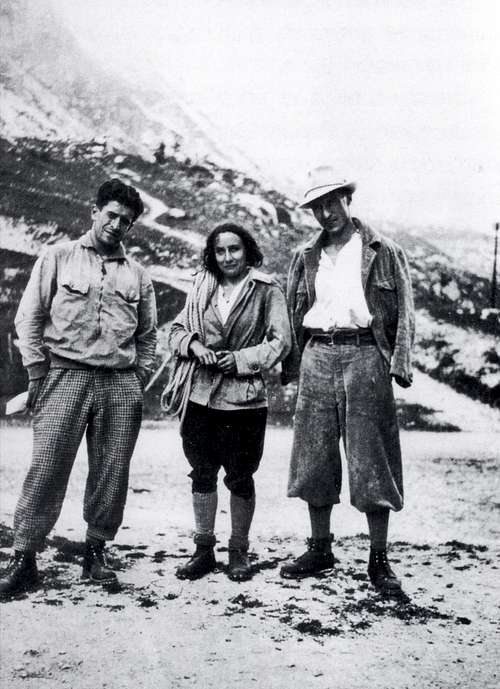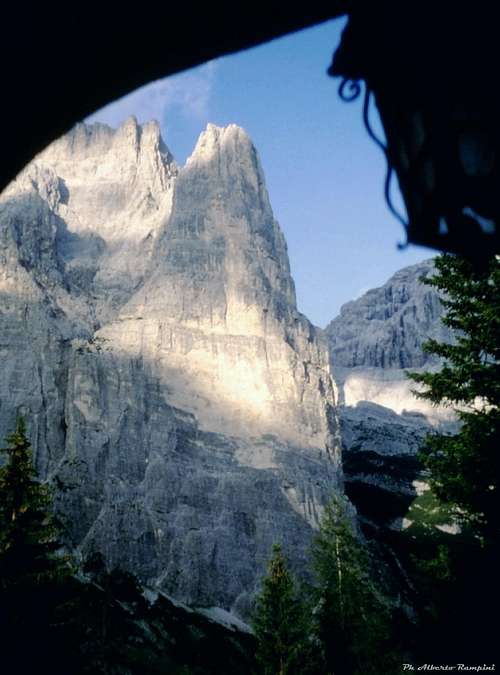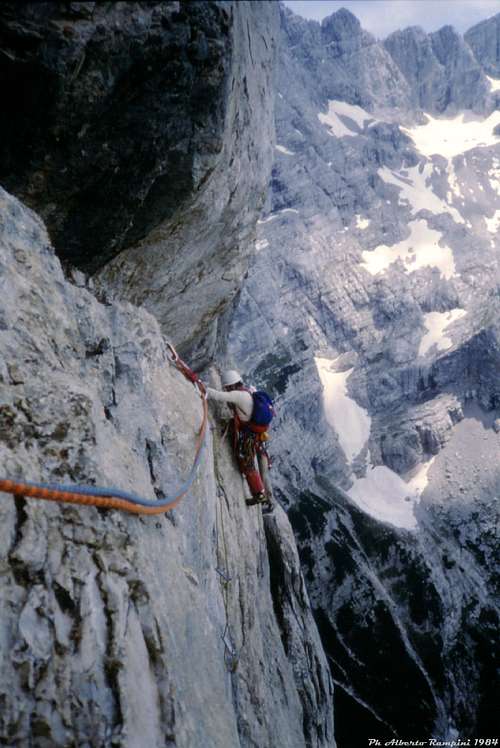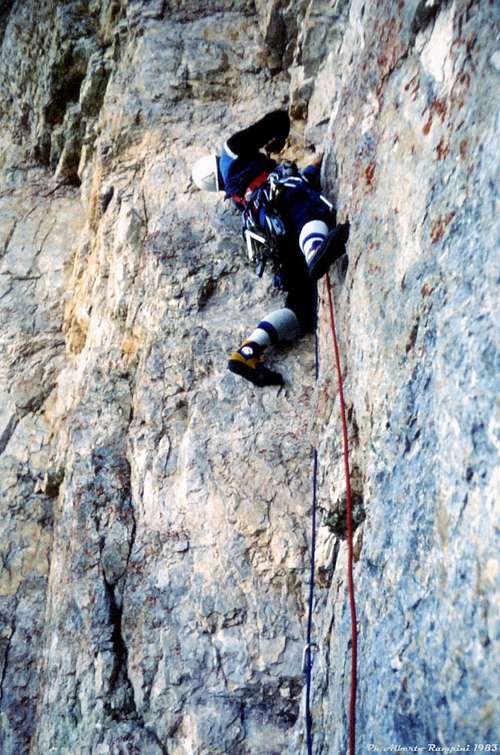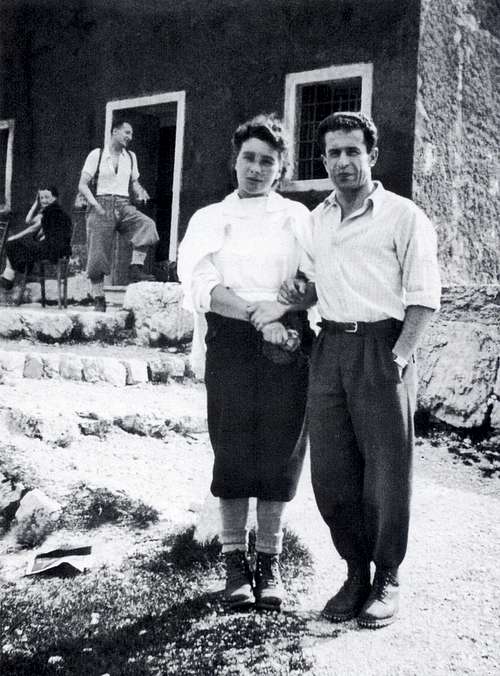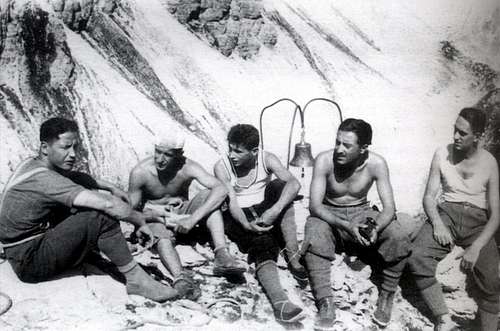-
 8916 Hits
8916 Hits
-
 89.39% Score
89.39% Score
-
 29 Votes
29 Votes
|
|
Article |
|---|---|
|
|
Mountaineering, Trad Climbing, Big Wall |
RAFFAELE "BIRI" CARLESSO
Raffaele "Biri" Carlesso, a pure artist of climbing
Comici-Dimai on Cima Grande di Lavaredo North face at the age of seventy-one and the overhanging Scoiattoli Direct on Torre Grande d’Averau at the age of eighty: these are Raffaele Carlesso’s incredible last enterprises by Raffaele Carlesso (Costa di Rovigo 1908 – Pordenone 2000). Truthfully awesome! A French mountaineer, having found his signature on Hasse-Brandler’s route-book on Cima Grande di Lavaredo in 1960s, asked if this signature was affixed by a son or by a namesake: he couldn’t believe that the matter in hand was the same famous Raffaele Carlesso climbing in the Thirties! Sixty years of climbs and about two thousands ascents represent his unique “curriculum”; self-trust, moral and physical strength, agility, deep self-esteem, steady training and high reliability, either in mountaineering or in life, were “his bow’s arrows”. Like his contemporary Emilio Comici, Raffaele, who was named “Biri”, a speedy racing car of those years, because of his quickness, had understood before time the importance of the methodical training. Born on September 15th 1908 in Costa di Rovigo (Veneto, Italy), a small town situated in the Po River Basin, in 1920 he removed to Pordenone, in Friuli-Venezia Giulia, which is considered his adopted town, while Valdagno, a little town nearby Little Dolomites, where he lived and worked for about ten years during its best period, is considered his second adopted town; here he made friendship with an excellent climbers’ group: Tita Casetta, Gino Soldà, Bortolo Sandri, Mario Menti, Umberto Conforto, Maria Luisa Orsini and others. Together with them Raffaele realized some hard routes on the Little Dolomites, leaving a strong trace inside the local mountaineering. However he was an outstanding exponent of the Italian and European climbing and mountaineering during the Sixth grade’s rowing years, he was neither a professional mountaineer nor a guide nor a man of the mountains: he was a pure non-professional climber, the youngest to be admitted to Club Alpino Accademico Italiano (at the age of 23); notwithstanding his town origin, during this period he reached and exceeded the VIth grade UIAA in free climbing, only climbing in the holidays and carrying a binding work. Only due to his absolute discretion and utmost reserve – he didn’t like writing about himself and he didn’t wish to be considered a climbing star, his name is not so famous as the one of others contemporaries, like Emilio Comici and Riccardo Cassin. His most important and world famous climbing routes are the 1st ascent of Torre Trieste South face (Civetta Group, Eastern Dolomites) in 1934 with Bortolo Sandri and the 1st ascent of Torre di Valgrande North-West face (Civetta Group) in 1936 with Mario Menti. And concluding: Raffaele Carlesso had the good sort of staying amongst his loved peaks till his life’s end.
Raffaele Carlesso masterpieces
The dilemma, unsolved during the years, about a work of art’s value, pending between pure abstraction’s aesthetical canons and concrete economic valuation, inside a cause-effect’s sequence which is very difficult to identify, doesn’t help us to draw our inspiration to deem the expressive masterpieces of a mountain’s artist as Raffaele Carlesso was. An artist who expressed his creation into a sphere which slips from the rules, even if changeable and not encoded, of an anomalous artistic action, inside which the critics and the market nothing can modify or alter or add to the creation’s primary and absolute meaning. How to value, in fact, a route’s intuition, its realization’s modalities, its connections with past climbing history and … with the future one? And then, in addition, does it exist a valuation or an univocal valuation’s possibility about a climbing route? Or is it best to deem the single aspects which concur to shape an always unique and unrepeatable masterpiece, but with a relative value always and always different? And besides, who are (if they can exist!) the critics authorized to word a valuation about such an “anomalous artistical expression”? Without probing longer the question and coming back to an empiric pragmatism’s level, we must however explain the overbearing concept of “work of art” emerging about the routes realized by Carlesso. Even for us, simple mountaineers, devoid of a specific artistic knowledge, but by instinct sensitive to the beauty, the main routes’ lines realized by the strong mountaineer can’t pass unnoticed. We consider as emblematic some of the best known, which we’re examining according to the climbing’s chronological order. Carlesso-Casetta Route on Soglio Rosso (Little Dolomites, Pasubio) – 1933, July, 16th This is one of the first “difficult” routes realized on Soglio Rosso South Face and it waited for almost twenty years to be climbed the second time. With the intuition which marks the “master-strokes”, between the many lines possible, Carlesso singled out a direct one, but achievable, showing very high difficulties, but not such as to force the wall’s nature. In the lower part’s climbing way, a wall without any lines suggesting a logical route, just showed itself one of the climber’s qualities: to face the wall designing his own line from hold to hold, with the objective adjusted on the general line imagined from the bottom. This was a deeply innovating idea, similar to the modern climbing’s logics rather than to the ones in that time. Building the route on a moves’ succession which creates a harmony’s line on a great virgin wall represents one of the author’s distinctive character. These considerations, however, refer to a relative valuation of the enterprise, setting it inside a determinate historical situation; they don’t affect the work’s artistic valuation which stays there, engraved on the Soglio Rosso impressive wall, giving life to the rock’s folds. Carlesso-Sandri Route on Torre Trieste – Civetta Group (1934, august, 7th/8th) Also Torre Trieste South wall’s climb is considered a further and high display of his art, inspired to beauty and logicality’s standards. Truthfully to beauty more than logicality, if we consider that there’s not a line imposed from the nature on this face.
Here, really, it wasn’t the wall to impose its evidence’s rules: the artist created his own work, with insight and sensitiveness. And also here he followed a logical thread, penetrating across wide impracticable zones and heading progressively towards the top in the middle of the summit castle. History tells to us about the first successful attempt to climb the wall without deviation. History tells to us some more about the route’s difficulties, highest than on the other VI+ routes in that age, like Cassin on Cima Ovest di Lavaredo and Soldà on Marmolada SW face and about the repetition’s long wait, until 1950s. The climb’s experience, even if by now a bit confused in the details, confirms the climbing’s extraordinary sequence and the meaning of a way to be covered, a winding thread continuously looking for itself, getting naturally to the summit. Without any errors, nor hesitations. Carlesso-Menti Route on Torre di Valgrande – Civetta Group (1936, july, 15th/16th) At the age of twenty-eight, after some different displays of creative vein, of climbing’s art moulding the ways and imposing a new climbing naturalness to the structures’ material naturalness, Carlesso only just a moment seems surrendering to a powerful call exerted by an extraordinary obviousness: Valgrande West face ideal crack was there and like an unfinished masterpiece it was waiting the master’s touch. The other great master, the Bellunese C.A.A.I. member Attilio Tissi stopped below the cracked roof which bars the entry to the yellow corner’s difficult section. Carlesso who didn’t know any climber stronger than himself, as he once told, was almost forced to win the obstacle using some pegs, to keep his own faith. And yet every peg fixed into the rock was considered as a kind of “sin” and “defeat” for the extreme free climbing which represented Carlesso’s faith. Also on Torre Trieste route some pegs were fixed, but here on Torre di Valgrande the matter was different: pegs were very important or, better, necessary to win the wall. The competitive need to win that line, already drawn by nature and already attempted by men, probably made the climbing’s way different. It was like the artist had been partially conditioned by the real world which interposed itself between the imagination and the creation. Carlesso’s proverbial reserve doesn’t consent to add many others details to his mountaineering history. Maybe they’re not necessary. Carlesso’s routes talk themselves and send forth a message of bright harmony and intriguing attraction, satisfying still today, eighty years later, a modern free climbing’s demand.
Chronology
Chronology 1922/1926 - Raffaele makes his first climbs in Col Nudo-Cavallo Group and on Campanile di Val Montanaia (Eastern Dolomites) 1927 – New routes on Col Nudo, Cima Manera and Cimon dei Furlani Since 1926 to 1933 he climbs several VI grade new routes on various peaks in the Little Dolomites, like Dito di Dio, Sisilla, Punta Sibele, Lontelovere ecc. 1931 – Cima Grande di Lavaredo North face attempt with Attilio Tissi, Andrich and Zanetti; Tofana di Rozes Stosser route and Cima Grande Stosser Route 1st repetitions with Ettore Castiglioni; Civetta Solleder-Lettembauer; Cima Busazza Videsott route 1st repetition1932 – Sass Maor Solleder route 1st repetition, Tofana di Rozes Tissi route 1st repetition 1933 – Soglio Rosso South face 1st ascent with T. Casetta; Soglio d’Uderle SE Chimney 1st ascent; Sibele East face 1st ascent with Gino Soldà and M. Luisa Orsini 1934 – Torre Trieste South face 1st ascent with Bortolo Sandri; Cima Grande di Lavaredo Comici-Dimai 1st italian repetition con G.B. Vinatzer 1935 – Baffelan Easth Face Direct route 1st ascent with Tita Casetta; Cima Ovest di Lavaredo North face attempt; 1936 – Torre di Valgrande NW face 1st ascent with Mario Menti; Cima Ovest di Lavaredo North face 2nd repetition with Gino Soldà; Cima Grande di Lavaredo Comici-Dimai with Gino Soldà; Civetta NW face Comici route; Marmolada Soldà-Conforto; 1953 – Campanile del Rifugio (Monfalconi) 1st ascent 1958 – Cima Ovest di Lavaredo Cassin route 1960 – Cima Grande di Lavaredo Hasse-Brandler route; Cima Piccolissima Lavaredo Cassin route 1961 - Campanile di Val Montanaia East face 1st ascent; Cima Grande di Lavaredo Hasse-Brandler route 1979 – Cima Grande di Lavaredo Comici-Dimai 1987 – Carlesso wins the Agordino d’Oro, Prize to the Discretion (Golden Agordino) 1988 – Cinque Torri: Torre Grande Direttissima Scoiattoli and Diretta Dimai
Books
"Raffaele Biri Carlesso - Gloria dell'Alpinismo Italiano" by Roberto Barato and Roberto Bianchini - C.A.I. Sez. Pordenone 2008
External Links
INTRAISASS VALDAGNO ANGELO ELLI C.A.I. PORDENONE ILGIORNALEDIVICENZA WIKIPEDIA MEDAGLIE D'ORO PARETI VERTICALI CARLESSO-SANDRI REPORT RAMELLA SERGIO CARLESSO-MENTI REPORT


